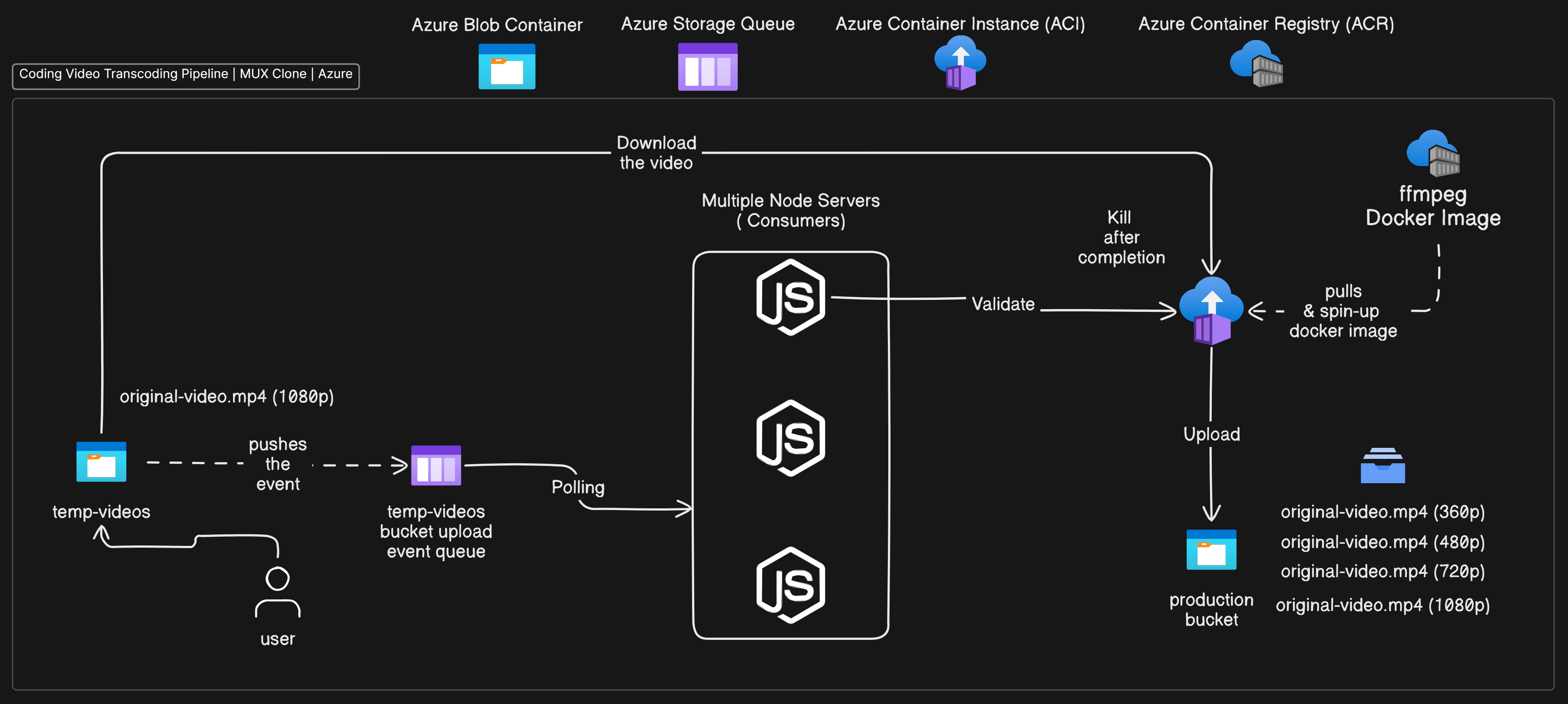https://github.com/vinayakvispute/multi-resolution-transcoder-pipeline-mux
A scalable pipeline for video transcoding, generating multiple resolutions with seamless integration into Azure, inspired by Mux's capabilities
https://github.com/vinayakvispute/multi-resolution-transcoder-pipeline-mux
automation azure azure-container-instances azure-container-registry azure-queue azure-storage blob-storage docker docker-container ffmpeg nodejs scalable sqs-queue typescript
Last synced: 7 months ago
JSON representation
A scalable pipeline for video transcoding, generating multiple resolutions with seamless integration into Azure, inspired by Mux's capabilities
- Host: GitHub
- URL: https://github.com/vinayakvispute/multi-resolution-transcoder-pipeline-mux
- Owner: VinayakVispute
- Created: 2024-08-28T12:04:35.000Z (about 1 year ago)
- Default Branch: main
- Last Pushed: 2024-10-05T16:37:39.000Z (about 1 year ago)
- Last Synced: 2025-03-29T12:11:36.879Z (8 months ago)
- Topics: automation, azure, azure-container-instances, azure-container-registry, azure-queue, azure-storage, blob-storage, docker, docker-container, ffmpeg, nodejs, scalable, sqs-queue, typescript
- Language: TypeScript
- Homepage: https://www.transcoder.visputevinayak.co/
- Size: 2.49 MB
- Stars: 2
- Watchers: 1
- Forks: 0
- Open Issues: 0
-
Metadata Files:
- Readme: README.md
Awesome Lists containing this project
README
# Multi-Resolution-Transcoder-Pipeline | Mux
A scalable video transcoding pipeline designed to convert videos into multiple resolutions, leveraging Azure's powerful cloud services. This project is inspired by Mux and demonstrates how to build a video processing pipeline that can be easily scaled to handle large volumes of videos.
## Table of Contents
- [Overview](#overview)
- [Tech Stack](#tech-stack)
- [Azure Services Used](#azure-services-used)
- [Pipeline Workflow](#pipeline-workflow)
- [Setup and Installation](#setup-and-installation)
- [Usage](#usage)
- [Contributing](#contributing)
- [License](#license)
## Overview
This project automates the process of transcoding videos into multiple resolutions using Azure services. The pipeline downloads a video from Azure Blob Storage, transcodes it into different resolutions (360p, 480p, 720p), and uploads the transcoded videos back to Azure Blob Storage with a suffix indicating the resolution. This allows for easy selection of videos based on desired resolution.
> Why settle for one resolution when you can have them all? Transcode like a ninja!✨
## Tech Stack
- **Node.js**: The runtime environment used to execute JavaScript code on the server side.
- **TypeScript**: Superset of JavaScript used for type safety and improved developer experience.
- **Fluent-ffmpeg**: A Node.js library for working with FFmpeg, used here for video transcoding.
- **Azure SDK for JavaScript**: Used for interacting with various Azure services.
## Azure Services Used
### 1. **Azure Blob Storage**
- **Purpose**: Used for storing the original video files and the transcoded videos.
- **Role**: The pipeline retrieves the input video from a specified container, processes it, and stores the output videos back in another container.
### 2. **Azure Storage Queue**
- **Purpose**: Used for queuing video processing requests.
- **Role**: The pipeline listens to the queue, retrieves messages, and processes videos accordingly. This allows for asynchronous processing and easy scaling.
### 3. **Azure Container Instances**
- **Purpose**: Provides a platform for running the containerized video transcoding service.
- **Role**: The pipeline spins up containers on demand to handle video transcoding, ensuring that resources are used efficiently.
### 4. **Azure Container Registry**
- **Purpose**: Stores container images.
- **Role**: The pipeline pulls the Docker image from the registry to spin up container instances for video processing.
## Pipeline Workflow

1. **Message Queue**: The pipeline starts by receiving a message from an Azure Storage Queue, which contains the name of the video blob to be processed.
2. **Video Download**: The pipeline downloads the video from Azure Blob Storage.
3. **Video Transcoding**: The video is transcoded into multiple resolutions using `fluent-ffmpeg`.
4. **Video Upload**: The transcoded videos are uploaded back to Azure Blob Storage with filenames that include the resolution suffix (e.g., `video-360p.mp4`).
5. **Repeat**: The pipeline continues to listen to the queue for new messages, allowing for continuous processing.
## Setup and Installation
### Prerequisites
- **Node.js** and **npm/yarn** installed.
- Azure account with the following services set up:
- Blob Storage containers (input and output)
- Storage Queue
- Container Registry with a Docker image for the transcoding service
- Container Instance setup
### Installation
1. **Clone the repository:**
```bash
git clone https://github.com/VinayakVispute/Multi-Resolution-Transcoder-Pipeline-Mux.git
cd Multi-Resolution-Transcoder-Pipeline-Mux
```
2. **Install dependencies:**
```bash
npm install
```
3. **Set up environment variables:**
Create a `.env` file in the root directory and populate it with the following values:
```
AZURE_STORAGE_CONNECTION_STRING=your_connection_string
AZURE_RESOURCE_GROUP=your_resource_group
AZURE_CONTAINER_REGISTRY_SERVER=your_registry_server
CONTAINER_GROUP_NAME=your_container_group_name
CONTAINER_NAME=your_container_name
BUCKET_NAME=input_blob_container_name
OUTPUT_VIDEO_BUCKET=output_blob_container_name
SUBSCRIPTION_ID=your_subscription_id
ACR_USERNAME=your_acr_username
ACR_PASSWORD=your_acr_password
QUEUE_NAME=your_queue_name
RESOURCE_GROUP_LOCATION=location_for_resource_group
```
4. **Run the pipeline:**
```bash
npm start
```
## Usage
- **Input**: The pipeline processes video files stored in an Azure Blob Storage container. The video file's name is extracted from a message received from an Azure Storage Queue.
- **Output**: The transcoded videos are stored in another Azure Blob Storage container with filenames suffixed with the resolution (e.g., `video-360p.mp4`, `video-480p.mp4`, `video-720p.mp4`).
## Contributing
Contributions are welcome! Please fork this repository, create a feature branch, and submit a pull request for any enhancements or fixes.
## License
This project is licensed under the MIT License - see the [LICENSE](LICENSE) file for details.
---
This README provides a comprehensive overview of your project, its components, and how to use it.